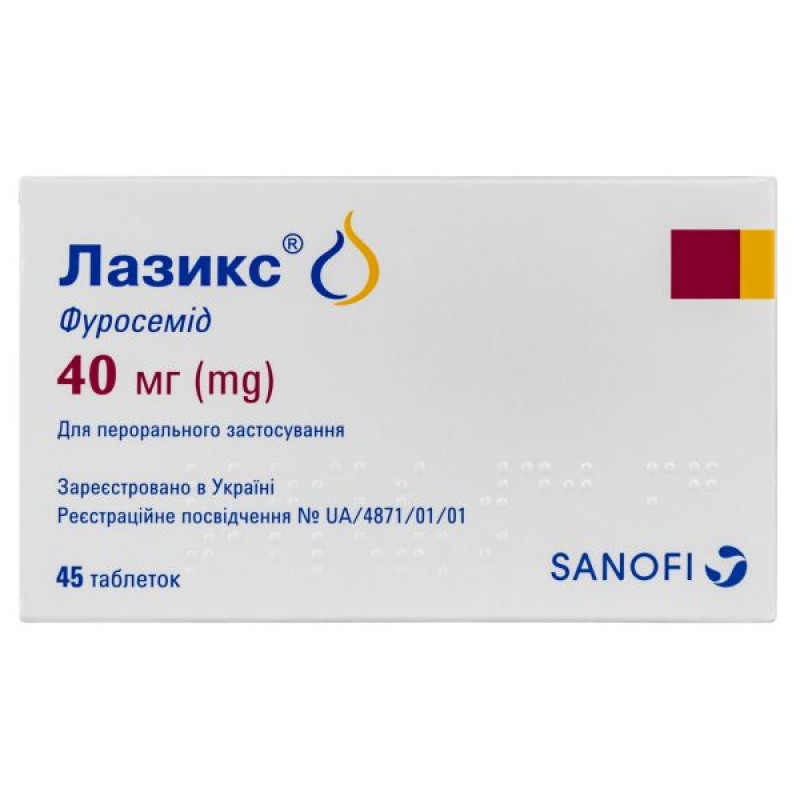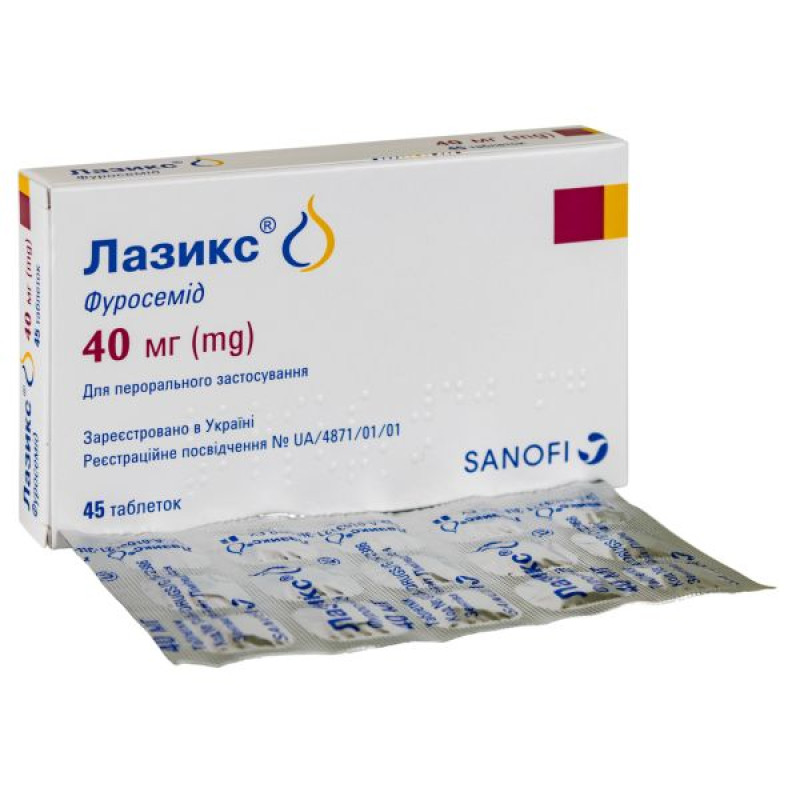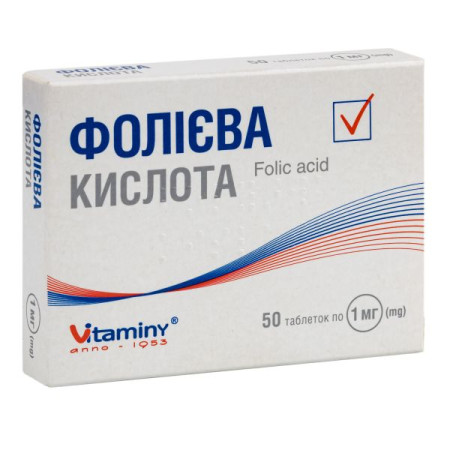Lasix tablets 40 mg strip #45

Instructions for Lasix tablets 40 mg strip No. 45
Composition
active ingredient: furosemide;
1 tablet contains furosemide 40 mg;
Excipients: lactose monohydrate, corn starch, pregelatinized starch, talc, colloidal anhydrous silicon dioxide, magnesium stearate.
Dosage form
Pills.
Main physicochemical properties: round white tablets with the letter code “DLI” printed above and below the score line on one side.
Pharmacotherapeutic group
Highly active diuretics. Sulfonamide preparations. ATX code C03C A01.
Pharmacological properties
Pharmacodynamics.
Furosemide is a fast-acting loop diuretic, which results in a relatively strong and short-term diuretic effect. Furosemide blocks the Na+K+2Cl- cotransporter located in the basal membranes of the cells of the thick segment of the ascending limb of the loop of Henle: the effectiveness of the saluretic action of furosemide therefore depends on whether the drug reaches the tubules in the lumen by an anion transport mechanism. The diuretic effect results from the reabsorption of sodium chloride in this segment of the loop of Henle. As a result, the fractional excretion of sodium can reach 35% of the glomerular filtration of sodium. Secondary effects of increased sodium excretion are increased urine output (due to osmotically bound water) and increased distal tubular secretion of potassium. The excretion of calcium and magnesium ions is also increased.
Furosemide causes dose-dependent stimulation of the renin-angiotensin-aldosterone system. In heart failure, furosemide leads to an acute reduction in cardiac afterload (by constricting the capacious venous vessels). This early vascular effect is prostaglandin-mediated and assumes adequate renal function with activation of the renin-angiotensin system and intact prostaglandin synthesis. In addition, due to its inherent natriuretic effect, furosemide reduces vascular reactivity to catecholamines, which is increased in patients with arterial hypertension.
The antihypertensive efficacy of furosemide is due to increased sodium excretion, decreased blood volume, and reduced vascular smooth muscle response to stimulation by vasoconstrictors or vasoconstrictor agents.
The onset of the diuretic effect is observed within 1 hour after oral administration of the drug.
A dose-dependent increase in diuresis and natriuresis was observed in healthy subjects receiving furosemide in doses of 10-100 mg. The duration of action in healthy subjects is approximately 3-6 hours after oral administration of 40 mg furosemide.
The effect of furosemide is reduced if there is reduced tubular secretion or interaction of the drug with albumin inside the tubules.
Pharmacokinetics.
Furosemide is rapidly absorbed from the gastrointestinal tract. The maximum absorption time is from 1 to 1.5 hours. The absorption of the drug shows significant individual variability.
The bioavailability of furosemide in healthy volunteers is approximately 50-70% for tablets. In patients, the bioavailability of the drug is affected by various factors, including existing diseases, and bioavailability may decrease to 30% (e.g., in nephrotic syndrome).
The possible effect of eating food at the same time as taking furosemide on the absorption of furosemide.
The volume of distribution of furosemide is 0.1 to 0.2 liters per 1 kg of body weight. The volume of distribution may be higher depending on the disease.
Furosemide (more than 98%) forms strong compounds with blood plasma proteins, especially with albumin.
Furosemide is excreted mainly as unchanged drug by secretion into the proximal tubule.
The metabolite of furosemide, the glucuronide, accounts for 10-20% of the substance in the urine. The remaining dose is excreted in the feces, presumably by biliary secretion.
Furosemide is excreted in breast milk; it crosses the placental barrier and slowly reaches the fetus. Furosemide is detected in the fetus or newborn in the same concentrations as in the mother.
• Kidney disease.
In renal failure, the elimination of furosemide is slowed and the half-life is prolonged; the terminal half-life may be up to 24 hours in patients with severe renal failure.
In nephrotic syndrome, reduced plasma protein concentrations lead to increased concentrations of unbound (free) furosemide. On the other hand, the efficacy of furosemide in these patients is reduced due to binding to intratubular albumin and reduced tubular secretion.
Furosemide is poorly dialyzable in patients undergoing hemodialysis, peritoneal dialysis, and chronic outpatient peritoneal dialysis.
• Liver failure.
In hepatic insufficiency, the half-life of furosemide increases by 30-90%, mainly due to a larger volume of distribution. It should also be noted that a wide variety of all pharmacokinetic parameters is observed in this group of patients.
The elimination of furosemide is slowed due to reduced renal function in patients with congestive heart failure, severe hypertension, and in elderly patients.
• Premature and full-term infants.
Depending on the level of renal development, the elimination of furosemide may be delayed. The metabolism of the drug is also reduced if the ability to glucuronidate is impaired in infants. The terminal half-life is less than 12 hours in fetuses older than 33 weeks after fertilization. In infants older than 2 months, the terminal clearance is the same as in adult patients.
Indication
• Edema in chronic congestive heart failure (if treatment with diuretics is necessary).
• Edema in chronic renal failure.
• Acute renal failure, including in pregnant women or during childbirth.
• Edema in nephrotic syndrome (if treatment with diuretics is necessary).
• Edema in liver diseases (if necessary - to supplement treatment with aldosterone antagonists).
• Arterial hypertension.
Contraindication
• Hypersensitivity to furosemide or to any of the excipients. Patients with a history of sulfonamide allergy (e.g., sulfonamide antibiotics or sulfonylureas) may be cross-sensitive to furosemide.
• Patients with hypovolemia or dehydration.
• Patients with renal failure in the form of anuria who do not respond to furosemide.
• Patients with renal failure due to poisoning with nephrotoxic or hepatotoxic drugs.
• Patients with severe hypokalemia.
• Patients with severe hyponatremia.
• Patients with precomatose and comatose states associated with hepatic encephalopathy.
• Breastfeeding.
• Pregnancy.
Interaction with other medicinal products and other types of interactions
Not recommended combinations.
In some cases, taking furosemide within 24 hours of chloral hydrate may cause flushing, increased sweating, agitation, nausea, increased blood pressure, and tachycardia. Therefore, concomitant use of furosemide and chloral hydrate is not recommended.
Furosemide may potentiate the ototoxicity of aminoglycosides and other ototoxic drugs. As this may result in irreversible damage, these drugs should not be used concomitantly with furosemide.
Combinations requiring precautions.
There is a risk of ototoxic effects when cisplatin and furosemide are used concomitantly. In addition, the nephrotoxicity of cisplatin may be enhanced unless furosemide is administered at low doses (e.g. 40 mg in patients with normal renal function) and with positive fluid balance when used to achieve a forced diuresis effect during cisplatin therapy.
Oral furosemide and sucralfate should not be administered less than 2 hours apart, as sucralfate reduces the absorption of furosemide from the intestine, i.e. reduces its effect.
Furosemide reduces the excretion of lithium salts and may lead to increased serum lithium levels, resulting in an increased risk of lithium toxicity, including a greater risk of cardiotoxic and neurotoxic effects of lithium. Therefore, careful monitoring of lithium levels is recommended in patients receiving this combination therapy.
Patients receiving diuretics may experience severe hypotension and deterioration of renal function, including cases of renal failure, especially when an angiotensin-converting enzyme inhibitor (ACE inhibitor) or angiotensin II receptor antagonist is first used, or when these drugs are first used in increased doses. It should be decided whether furosemide should be temporarily discontinued, or at least the dose of furosemide should be reduced 3 days before starting treatment, or the dose of the ACE inhibitor or angiotensin II receptor antagonist should be increased.
Risperidone: Caution should be exercised and the risk and benefit should be carefully weighed before deciding on combination therapy or concomitant use with furosemide or other potent diuretics.
Levothyroxine: high doses of furosemide may inhibit the binding of thyroid hormones to the carrier protein, and therefore lead initially to a temporary increase in the levels of free thyroid hormone fractions, followed by an absolute decrease in the levels of total thyroid hormone fractions.
Thyroid hormone levels should be monitored.
Combinations to consider.
Concomitant use of nonsteroidal anti-inflammatory drugs, including acetylsalicylic acid, may reduce the effect of furosemide. In dehydrated or hypovolemic patients, nonsteroidal anti-inflammatory drugs may lead to acute renal failure. Salicylate toxicity may be increased by furosemide.
The use of corticosteroids, carbenoxolone, licorice root in large doses, and long-term use of laxatives may increase the risk of developing hypokalemia.
Some electrolyte imbalances (such as hypokalemia, hypomagnesemia) may increase the toxicity of certain other drugs (e.g., digitalis drugs and drugs that cause QT prolongation syndrome).
If antihypertensive drugs, diuretics or other drugs that have the property of lowering blood pressure are used simultaneously with furosemide, an even greater decrease in blood pressure should be expected.
Probenecid, methotrexate and other drugs that, like furosemide, undergo significant renal tubular secretion may reduce the effectiveness of furosemide. Conversely, furosemide may reduce the renal excretion of these drugs. Treatment with high doses (including both furosemide and other drugs) may lead to increased serum levels and an increased risk of side effects caused by furosemide or concomitant therapy.
The effectiveness of antidiabetic drugs and sympathomimetics that have the property of increasing blood pressure (e.g., epinephrine, norepinephrine) may be reduced. The effect of curare-like muscle relaxants or theophylline may be enhanced.
The harmful effects of nephrotoxic drugs on the kidneys may be increased.
Renal impairment may develop in patients receiving concomitant therapy with furosemide and high doses of certain cephalosporins.
Concomitant use of cyclosporine A and furosemide is associated with an increased risk of gouty arthritis secondary to furosemide-induced hyperuricemia and cyclosporine-induced impairment of renal urate excretion.
In patients at high risk for contrast-induced nephropathy, furosemide treatment was associated with a higher incidence of renal function deterioration after contrast administration compared with high-risk patients who received only intravenous hydration prior to contrast administration.
Application features
During treatment with Lasix®, continuous urine flow should be ensured. Patients with partial urinary outflow obstruction require close attention, especially in the initial stages of treatment.
Treatment with Lasix® requires regular medical supervision.
Particularly careful monitoring is required:
• patients with arterial hypotension;
• patients who are at particular risk due to a significant decrease in blood pressure, for example, patients with severe stenosis of the coronary arteries or blood vessels supplying blood to the brain;
• patients with latent or severe diabetes mellitus;
• patients with gout;
• patients with hepatorenal syndrome, i.e. with functional renal failure associated with severe liver disease;
• patients with hypoproteinemia, for example, associated with nephrotic syndrome (the effect of furosemide may be reduced with potentiation of ototoxicity). Careful dose titration is necessary;
• premature infants (possible development of nephrocalcinosis/nephrolithiasis); renal function should be monitored and renal ultrasonography performed.
Regular monitoring of serum sodium, potassium and creatinine is generally recommended during furosemide therapy. Particularly careful monitoring is required in patients at high risk of developing electrolyte imbalances or in cases of significant additional fluid loss (e.g. as a result of vomiting, diarrhoea or excessive sweating). Hypovolaemia or dehydration, as well as any significant disturbances of electrolyte and acid-base balance, should be corrected. This may require temporary discontinuation of furosemide therapy.
The development of electrolyte imbalances is influenced by factors such as existing diseases (e.g. cirrhosis, heart failure), concomitant medication, and diet. For example, vomiting or diarrhea can lead to a potassium deficiency.
When using Lasix®, it is advisable to recommend that the patient consume foods high in potassium (baked potatoes, bananas, tomatoes, spinach, dried fruits). It should be remembered that when using Lasix®, there may be a need for medication to compensate for potassium deficiency.
Concomitant use with risperidone.
In placebo-controlled trials of risperidone in elderly patients with dementia, higher mortality rates were observed in patients receiving furosemide plus risperidone compared with patients receiving risperidone alone or furosemide alone.
The drug contains lactose, therefore patients with rare hereditary forms of galactose intolerance, lactase deficiency or glucose-galactose malabsorption syndrome should not use this medicine.
When using the drug, there is a possibility of exacerbation or activation of systemic lupus erythematosus.
Use during pregnancy or breastfeeding
Furosemide crosses the placental barrier and should not be administered during pregnancy.
Furosemide passes into breast milk and may inhibit lactation. Women should discontinue breastfeeding during treatment with furosemide.
Ability to influence reaction speed when driving vehicles or other mechanisms
Some side effects (for example, an unexpected significant decrease in blood pressure) may impair the patient's ability to concentrate and react quickly, so you should refrain from driving or operating other machinery during treatment.
Method of administration and doses
The dosage regimen is set by the doctor individually, depending on the severity of water and electrolyte balance disorders, the value of glomerular filtration, the severity of the patient's condition. During the use of the drug, the indicators of water and electrolyte balance should be adjusted taking into account diuresis and the dynamics of the patient's general condition. The drug should be used on an empty stomach.
The recommended maximum daily dose of furosemide for adults is 1500 mg.
Special dosage recommendations.
Dosage for adults is generally based on the following recommendations.
• Edema in chronic congestive heart failure.
The recommended initial dose of the drug for oral administration is 20-50 mg per day. If necessary, the dose can be adjusted depending on the patient's therapeutic response. It is recommended to take the daily dose divided into 2 or 3 doses.
• Edema in chronic renal failure.
The natriuretic effect of furosemide depends on a number of factors, including the severity of renal insufficiency and sodium balance. Therefore, it is not possible to predict the exact dose. In patients with chronic renal insufficiency, the dose should be carefully titrated to ensure a gradual initial fluid loss. For adult patients, this means using a dose that results in a daily weight loss of approximately 2 kg (approximately 280 mmol Na+).
The recommended initial daily dose for oral administration is 40-80 mg. If necessary, the dose can be adjusted depending on the patient's therapeutic response. The total daily dose can be administered once or divided into 2 doses. For patients on hemodialysis, the total daily oral dose is 250-1500 mg.
• In acute renal failure, hypovolemia, arterial hypotension, and significant electrolyte and acid-base imbalance should be compensated for before starting furosemide.
It is recommended to switch from intravenous to oral administration as soon as possible.
• Edema in nephrotic syndrome.
The recommended initial oral dose is 40-80 mg per day. If necessary, the dose can be adjusted depending on the patient's therapeutic response. The total daily dose can be administered once or divided into several doses.
• Edema in liver diseases.
Furosemide should be used as an adjunct to aldosterone antagonist therapy when aldosterone antagonist therapy alone is inadequate. To avoid complications such as orthostatic hypotension or electrolyte and acid-base disturbances, the dose should be titrated carefully to ensure a gradual initial fluid loss. For adult patients, this means using a dose that results in a daily weight loss of approximately 0.5 kg.
The recommended initial daily oral dose is 20-80 mg. If necessary, the dose can be adjusted depending on the patient's therapeutic response. The total daily dose can be administered as a single dose or divided into several doses. If intravenous administration is absolutely necessary, the initial single dose is 20-40 mg.
Children.
The drug in this dosage form should be prescribed to children weighing more than 10 kg.
For children, the recommended oral dose of furosemide is 2 mg/kg body weight, but the maximum daily dose should not exceed 40 mg.
For children who cannot take the oral dosage form, such as premature infants and neonates, parenteral administration should be considered.
Overdose
Symptoms: The clinical picture of acute or chronic overdose depends mainly on the degree and consequences of electrolyte and fluid loss and includes signs such as hypovolemia, dehydration, hemoconcentration, cardiac arrhythmias (including AV block and ventricular fibrillation). Symptoms of these disorders include severe arterial hypotension (progressing to shock), acute renal failure, thrombosis, delirium, peripheral paralysis, apathy and confusion.
Treatment: There are no specific antidotes for furosemide. Therapy is symptomatic.
Adverse reactions
The frequency of adverse reactions is based on literature references from studies in which furosemide was used in a total of 1387 patients at any dose for any indication. If the same adverse reaction was assigned to different frequency categories in different sources, the highest frequency category was chosen. Where possible, the following CIOMS criteria were used to group adverse reactions by frequency: very common (≥ 10%); common (≥ 1% to < 10%); uncommon (≥ 0.1% to < 1%); rare (≥ 0.01% to < 0.1%); very rare (< 0.01%); frequency unknown (cannot be estimated from the available data).
Metabolic and nutritional disorders
Very common: electrolyte imbalance (including symptomatic), dehydration and hypovolemia, especially in elderly patients, increased blood creatinine levels, increased blood triglyceride levels.
· Common: hyponatremia, hypochloremia, hypokalemia, increased blood cholesterol levels, increased blood uric acid levels, gout attacks.
· Uncommon: impaired glucose tolerance. The course of diabetes mellitus may progress from latent to overt.
Frequency unknown: hypocalcemia, hypomagnesemia, increased blood urea, metabolic alkalosis, pseudo-Bartter syndrome with improper and/or prolonged use of furosemide.
From the vascular side
Very common (when used as an intravenous infusion): hypotension, including orthostatic hypotension.
Rare: vasculitis.
Frequency unknown: thrombosis.
Renal and urinary tract disorders
· Common: increased urine volume.
Rare: tubulointerstitial nephritis.
Frequency unknown:
- increased sodium levels in the urine, increased chlorine levels in the urine, urinary retention (in patients with partial obstruction of urine outflow);
- nephrocalcinosis/nephrolithiasis in premature infants;
- renal failure.
Gastrointestinal tract
Uncommon: nausea.
Rare: vomiting, diarrhea.
Very rare: acute pancreatitis.
Hepatobiliary disorders
Very rare: cholestasis, increased transaminase levels.
Hearing and balance disorders
· Uncommon: hearing impairment, which is usually transient, especially in patients with renal insufficiency, hypoproteinaemia (e.g. nephrotic syndrome) and/or in the case of too rapid intravenous administration of furosemide. Cases of deafness, sometimes irreversible, have been reported after oral or intravenous administration of furosemide.
Rare: ringing in the ears.
Skin and subcutaneous tissue disorders
· Uncommon: pruritus, urticaria, rash, bullous dermatitis, erythema multiforme, pemphigoid, exfoliative dermatitis, purpura, photosensitivity reaction.
Frequency unknown: Stevens-Johnson syndrome, toxic epidermal necrolysis, acute generalized exanthematous pustulosis (AGEP) and DRESS syndrome (drug rash with eosinophilia and systemic symptoms).
On the part of the immune system
Rare: severe anaphylactic or anaphylactoid reactions (including those accompanied by shock).
Frequency unknown: exacerbation or activation of systemic lupus erythematosus.
From the nervous system
Rare: paresthesia.
· Common: hepatic encephalopathy in patients with hepatocellular insufficiency.
Blood and lymphatic system disorders
· Common: hemoconcentration.
Uncommon: thrombocytopenia.
Rare: leukopenia, eosinophilia.
Very rare: agranulocytosis, aplastic anemia or hemolytic anemia.
Musculoskeletal and connective tissue disorders
Frequency unknown: Cases of rhabdomyolysis have been reported, often in the setting of severe hypokalemia (see section "Contraindications").
Congenital and hereditary/genetic disorders
Frequency not known: Increased risk of ductus arteriosus obstruction if furosemide is administered to premature infants during the first weeks of life.
General disorders and administration site conditions
Rare: increased body temperature.
Expiration date
4 years.
Storage conditions
Keep out of reach of children.
Store in original packaging at a temperature not exceeding +30 °C.
Packaging
No. 45 (15x3): 15 tablets in a strip, 3 strips in a cardboard box.
Vacation category
According to the recipe.
Producer
Sanofi India Limited, India.
Location of the manufacturer and its business address
Plot No. - 3501, 3503-15, 6310 B-14, GIDC Estate, AT & Post.- Ankleshwar - 393 002, Dist. - Bharuch, Gujarat, India/Plot No. - 3501, 3503-15, 6310 B-14, GIDC Estate, AT & Post.- Ankleshwar - 393 002, Dist. - Bharuch, Gujarat, India.
There are no reviews for this product.
There are no reviews for this product, be the first to leave your review.
No questions about this product, be the first and ask your question.

















